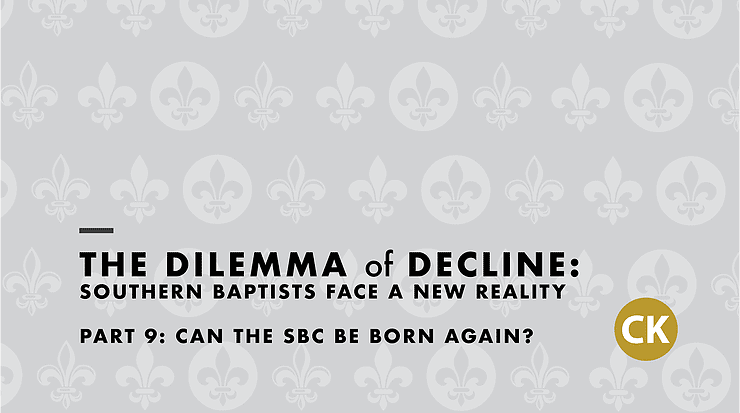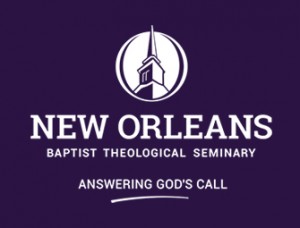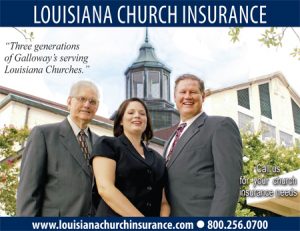By Chuck Kelley
In 1938, prominent Methodist pastor and scholar W. E. Sangster published a small book entitled Methodism Can Be Born Again. For two hundred years, Methodists were among the most evangelistic and missional of all Protestant denominations, and at the time, they were the largest family of churches in the nation and around the world in most categories. To suggest they needed to be born again as a denomination shocked many. Sangster felt duty-bound to share an unpopular message with his Methodist brethren because he saw the growing statistical evidence of decline in Methodist life. Eight decades ago Sangster wrote:
“Recent statistics are as dismally impressive as past statistics were startling in their triumphs. One turns over the sad record of recent years and finds a fearful wastage at work.”
“So the decline goes on and no sober observer expects a swift reversal. A child can easily foresee the ultimate outcome of all this unless it is stopped.”
“God can do something with the faithful, beaten to their knees, but who can manage a man who denies that anything is wrong, and thinks that all is well with Methodism because things are not too bad in his corner.”
“A general recognition of the gravity of the hour, and a humbling of ourselves before God would help us all.”
“Pert disparagement of the statistics must end. The figures mean something—and something very serious.” (pp. 16-17, 20)
Southern Baptists Are the New Methodists
Where Methodists were in 1938, Southern Baptists are today. (See Blog 8 in the series: https://www.drchuckkelley.com/post/the-dilemma-of-decline-part-8-where-are-we-now.) The declining statistics of Methodism that so concerned Sangster were not reversed in the years that followed his book, and Methodism went on to experience worldwide losses, including the fastest loss of membership in the history of American Christianity. In 1837, Hans Christian Anderson of fairy tale fame, wrote a tale about two weavers commissioned by the King to make new clothes for him. The weavers said they created the most spectacular clothes ever made, but those clothes would be invisible to all who were unworthy of a royal position or “unpardonably stupid.” The emperor put on these supposedly magnificent clothes and paraded before his subjects with great pride. All were too worried about being considered stupid or unworthy of their position to say anything, until a child finally cried out, “The emperor is not wearing any clothes!” Finally, everyone could acknowledge the truth of what their eyes had seen. The supposedly magnificent clothes did not really exist. Neither does significant Great Commission progress in the SBC for the last decade and more.
Fellow Southern Baptists, the reality underneath our glowing reports and SBC pride is that our Convention is in serious trouble. We may use Great Commission language, but we are not achieving Great Commission results. There are and ever will be some strong, healthy churches out there, but that cannot be said today of the SBC as a family of churches. This decline cannot be attributed solely to the difficult circumstances faced by today’s churches. The Great Depression era was an extremely difficult time in the U.S., but Southern Baptists had an average membership gain of 101,468 people per year during the Depression. However, in the decade since the “Great Commission Resurgence” launched, we lost nearly 2,000,000 members and are baptizing fewer people than we did in 1938. In 1939, SBC churches averaged one baptism per 17.9 members. Last year the churches averaged only one baptism per 62 members.
What happened to Methodism after the unheeded warnings of W. E. Sangster is a haunting illustration of what lies ahead for the SBC. Without changes, things can and will get still worse. The ebb tide of evangelistic decline eventually, inevitably lowers all boats.
Decline never simply disappears. Decline gathers momentum and broadens, working its way into more and more areas. What began as a significant drop in baptisms has now spread to nearly every statistical category. When negative momentum grows, downward trends become harder and more complex to reverse. SBC decline has reached the point of requiring a massive, intentional strategic response sustained over a number of years to reverse the trends.
Where Do We Start?
Declare the rebirth of evangelism! Publicly. SBC leaders need to acknowledge that our Convention is in the grip of a historic decline affecting nearly everything in SBC life. The Convention must recover its identity as a family of congregations who continually seeks the lost in their communities and connects those of all ages who are born again into an ongoing process of congregational discipleship. For most of our history, that has been our distinctive identity.
Restructure NAMB. NAMB leadership must return to a passionate embrace of the historic SBC assignment to assist churches with evangelism. The SBC needs a strategic plan that identifies reasonable evangelistic goals and includes additional personnel, national infrastructure, and dedicated budget to help churches reach those goals. NAMB cannot help SBC churches recover a vibrant evangelistic culture unless it recreates its own evangelistic culture.
Focus on the essentials. Win the children of the church and community to Christ, baptizing them and guiding them into life as disciples of Christ. Teach students the basic skills and practices of discipleship, including how to walk with God, discern truth, and live on mission to reach others. Engage adults in Bible study and some aspect of ministry in the church. Use every means to share Christ and invite people to salvation. A variety of methods is crucial.
Most importantly, REPENT! All of us and each of us must repent. In the words of a timeless hymn, “All is vain unless the Spirit of the Holy One comes down.” God must move in us first, if He is ever to move in our churches. God will not bless those unpleasing to Him. We must become blessable or we will become expendable. The hindrance to revival is us. All of us.
Pastor’s Take Away: God is able to give the SBC a bright future. He is waiting to see if we are willing to meet His requirements for sending the Spirit’s fire. Pastors, go after the lost. That is what Jesus did. Go! Go! Go! Be holy in your lifestyle, and go after the lost.




